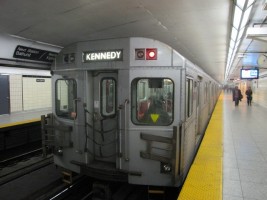
Rohr 1076
Location: National Airport Station, Arlington, VA
Operator of Vehicle: Washington Metropolitan Area Transit Authority
Date of Photo: November 27, 2003
The DC Metrorail is known for its uniformity. Out of the 91 stations currently in service, only two of them have two platforms served by three tracks: West Falls Church and National Airport. The center track at the former station typically only gets used by trains pulling out from or pulling in to the nearby West Falls Church yard. However, the center track at the latter station has seen daily use every few minutes at several different times in the station’s 42 years of service.
The most recent of these circumstances is ongoing. Since last weekend, the six stations south of National Airport are closed for platform reconstruction that will last until early September. As a result, for the first time since 1983, National Airport is the last stop for all Blue and Yellow line trains in Virginia. According to The Story of Metro by Ronald H. Deiter, it was not uncommon during the period that National Airport was the last stop for all trains from 1977 until 1983 to see two trains moving through the station in the same direction simultaneously. The reason this would occur is that there is no direct crossover from the outbound track to the inbound track, and there was not necessarily enough time between trains to have a train arrive on the center track, drop off its passengers, pick up new passengers, and head back towards Downtown DC. As a result, the following moves would occur:
- A train would arrive on the outbound track and discharge its passengers.
- The next train would arrive on the middle track and discharge its passengers.
- The train on the outbound track would proceed south of the station.
- The train on the middle track would proceed south of the station and cross over to the inbound track.
- The train on the outbound track would reverse direction and reenter the station on the middle track to pick up passengers.
- The train on the inbound track would reverse direction and reenter the station, staying on the inbound track.
- Both trains would collect new passengers and proceed in to Downtown DC.
If steps 3 and 4 or steps 5 and 6 occurred concurrently to each other, you had the two trains moving in the same direction through the station simultaneously.
Metro seems to be using only the center track as much as possible so we may not see this scenario play out in the next few months, but perhaps some lucky railfan will observe it. After all, luckily running into the unexpected is one of the joys of this hobby. That said, you will not be able to run into a 1000 Series car, like the one seen here, anytime soon. Those have all been retired.
Also, for anyone wondering, the other times the center track was used on a regular basis is between 1983 and 1991 when Blue Line trains terminated at National Airport but Yellow Line trains continued south to Huntington, and in late 2002 and early 2003 during platform canopy construction to extend the station canopies to the north entrance constructed when the new airport terminal opened in 1997.
For more photos of WMATA’s 1000 Series Rail Cars, please click here.






